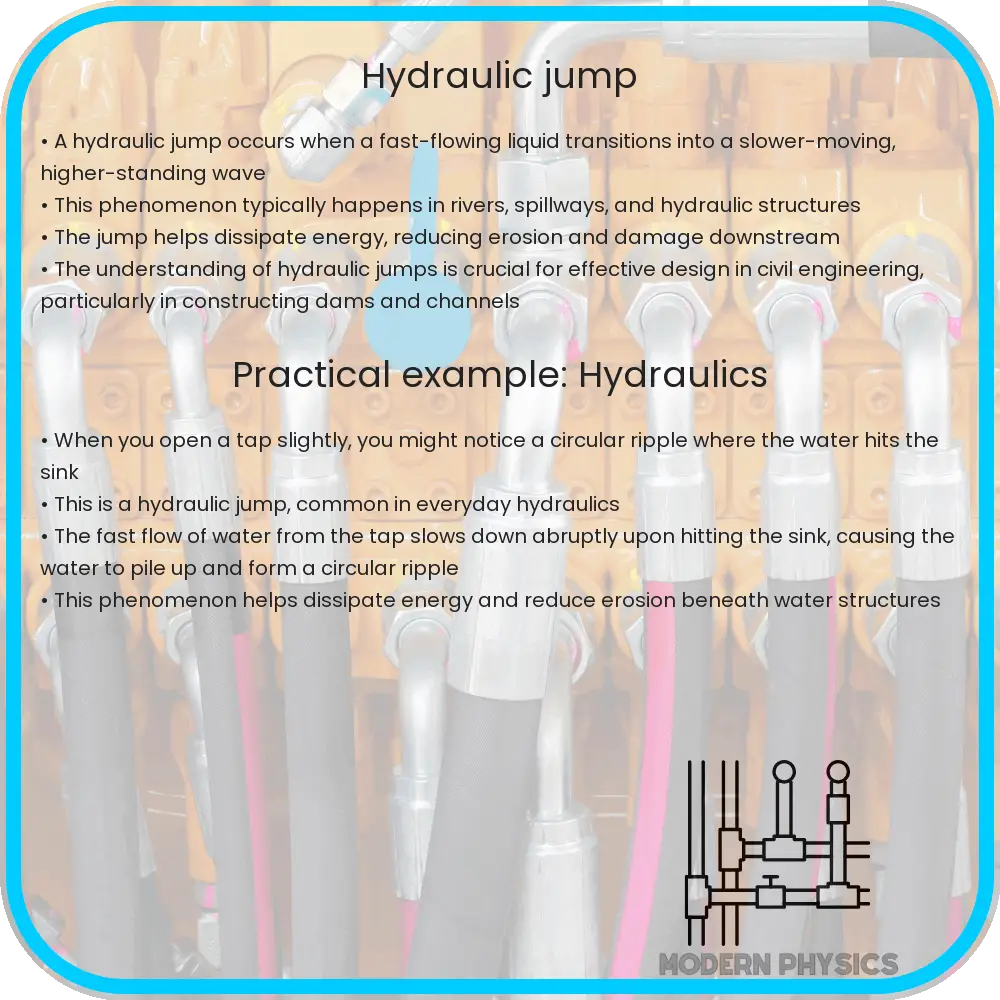Explore the dynamics of hydraulic jumps in fluid mechanics, their role in energy dissipation, flow control, and environmental impact analysis.

Understanding Hydraulic Jump: A Fundamental Phenomenon in Fluid Mechanics
Hydraulic jump is a fascinating and essential phenomenon in the field of fluid mechanics, particularly relevant in hydraulic engineering and environmental studies. This phenomenon occurs when a high-velocity, low-depth flow transitions suddenly to a low-velocity, high-depth flow. The practical applications of understanding and controlling hydraulic jumps are vast, ranging from energy dissipation in dam spillways to flow control in irrigation channels.
Energy Dissipation in Hydraulic Jumps
One of the critical roles of hydraulic jumps is in the dissipation of energy. When water flows over structures like spillways or weirs, the kinetic energy can be destructive. A hydraulic jump transforms some of this kinetic energy into heat and sound energy, reducing the erosive potential of the flow. This process is crucial for protecting hydraulic structures and minimizing erosion downstream.
Flow Control Through Hydraulic Jumps
Hydraulic jumps also serve as an effective tool for flow control in various engineering applications. By manipulating flow conditions and channel geometry, engineers can create hydraulic jumps to regulate flow speed, depth, and pressure. This ability is particularly useful in water treatment processes, where controlling the flow rate is essential for efficient operation.
Analysis of Hydraulic Jumps
The analysis of hydraulic jumps involves understanding the relationships between various flow parameters. The Froude number (Fr), a dimensionless number, is crucial in this analysis. It is defined as \( Fr = \frac{v}{\sqrt{g \cdot d}} \), where \( v \) is the flow velocity, \( g \) the acceleration due to gravity, and \( d \) the flow depth. When \( Fr > 1 \), the flow is supercritical (rapid), and when \( Fr < 1 \), it is subcritical (slow).
The transition from supercritical to subcritical flow conditions characterizes a hydraulic jump. The jump’s effectiveness in energy dissipation is quantified by the energy loss, which can be calculated using the initial and final depths of the flow. The relationship between these depths is given by the Belanger equation, \( \frac{d_2}{d_1} = \frac{1}{2}\left( \sqrt{1 + 8 \cdot Fr_1^2} – 1 \right) \), where \( d_1 \) and \( d_2 \) are the depths before and after the jump, respectively.
This analysis is essential for designing effective hydraulic structures and managing water resources. By understanding the mechanics of hydraulic jumps, engineers can predict and control the behavior of flowing water in various situations, leading to safer and more efficient water management systems.
Practical Applications and Challenges in Hydraulic Jump Management
Implementing hydraulic jumps in real-world scenarios requires meticulous planning and design. The engineering of spillways, sluice gates, and other hydraulic structures often incorporates hydraulic jumps to enhance safety and efficiency. In urban drainage systems, hydraulic jumps are used to reduce flow velocities, thus preventing damage to infrastructure. Moreover, in wastewater treatment, hydraulic jumps aid in oxygenating the water and mixing chemicals, enhancing treatment processes.
Environmental Impacts and Considerations
While hydraulic jumps are beneficial in controlling water flow, they also have environmental implications. The turbulence and aeration caused by hydraulic jumps can disrupt aquatic ecosystems, particularly in areas with sensitive fish populations. Therefore, environmental impact assessments are crucial when designing hydraulic structures that induce hydraulic jumps.
Advanced Analysis and Future Developments
With advancements in computational fluid dynamics (CFD) and other analytical techniques, the understanding of hydraulic jumps continues to evolve. Researchers are now able to simulate complex flow scenarios, allowing for more precise design and prediction of hydraulic jumps. Future developments may include more sustainable and environmentally friendly designs that minimize ecological impacts while maximizing the benefits of hydraulic jumps in water management.
Conclusion
In conclusion, the hydraulic jump is a fundamental and multifaceted phenomenon in fluid mechanics with significant applications in hydraulic engineering and environmental management. Its role in energy dissipation protects infrastructure from erosion and damage, while its ability to control flow rates is essential in water treatment and management. The analysis of hydraulic jumps, primarily through dimensionless parameters like the Froude number, enables engineers to design effective and efficient water systems. However, the environmental impacts of these jumps must be carefully considered to ensure ecological balance. As technology advances, the analysis and application of hydraulic jumps will continue to evolve, offering innovative solutions for managing Earth’s most vital resource – water.
